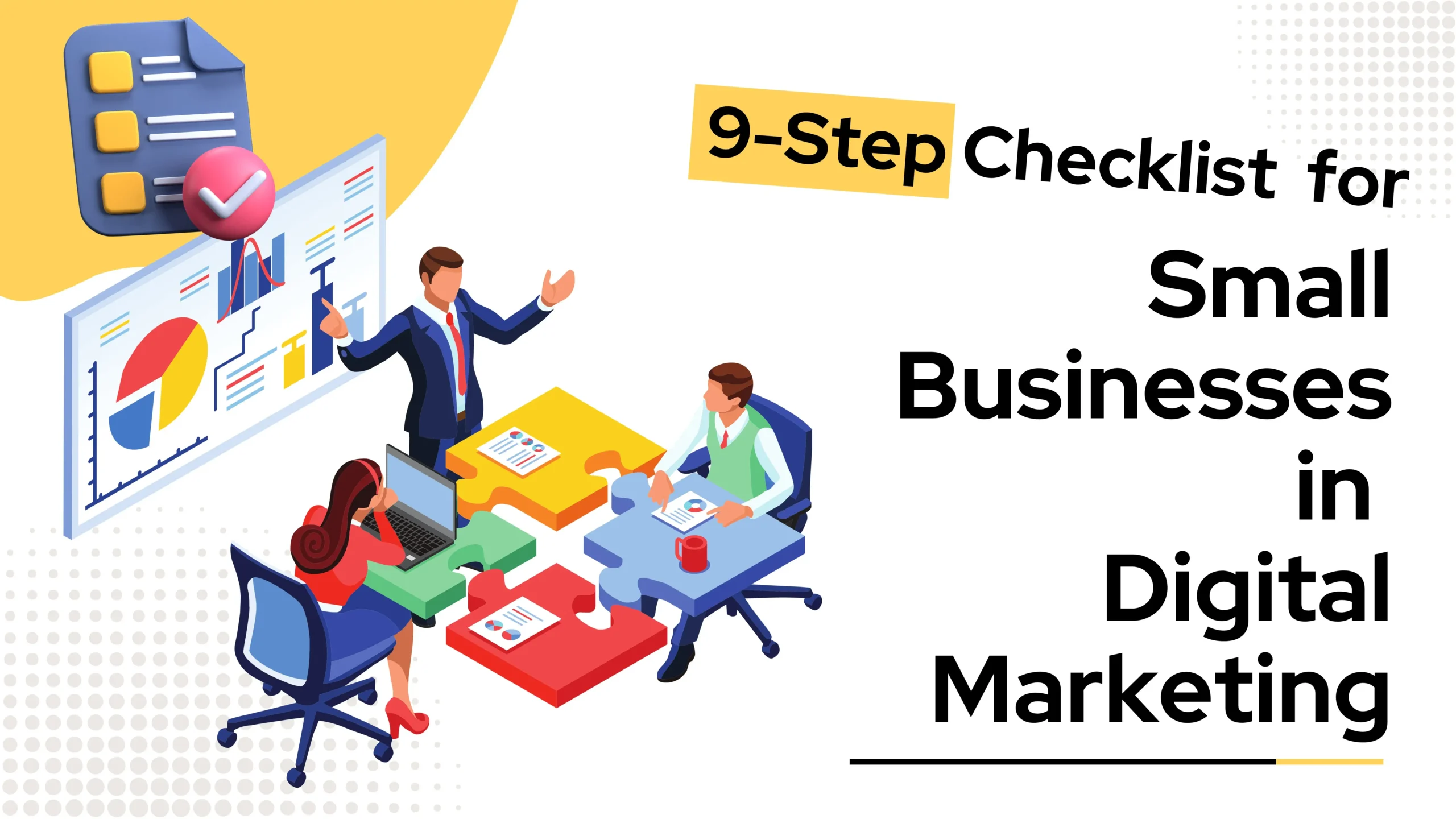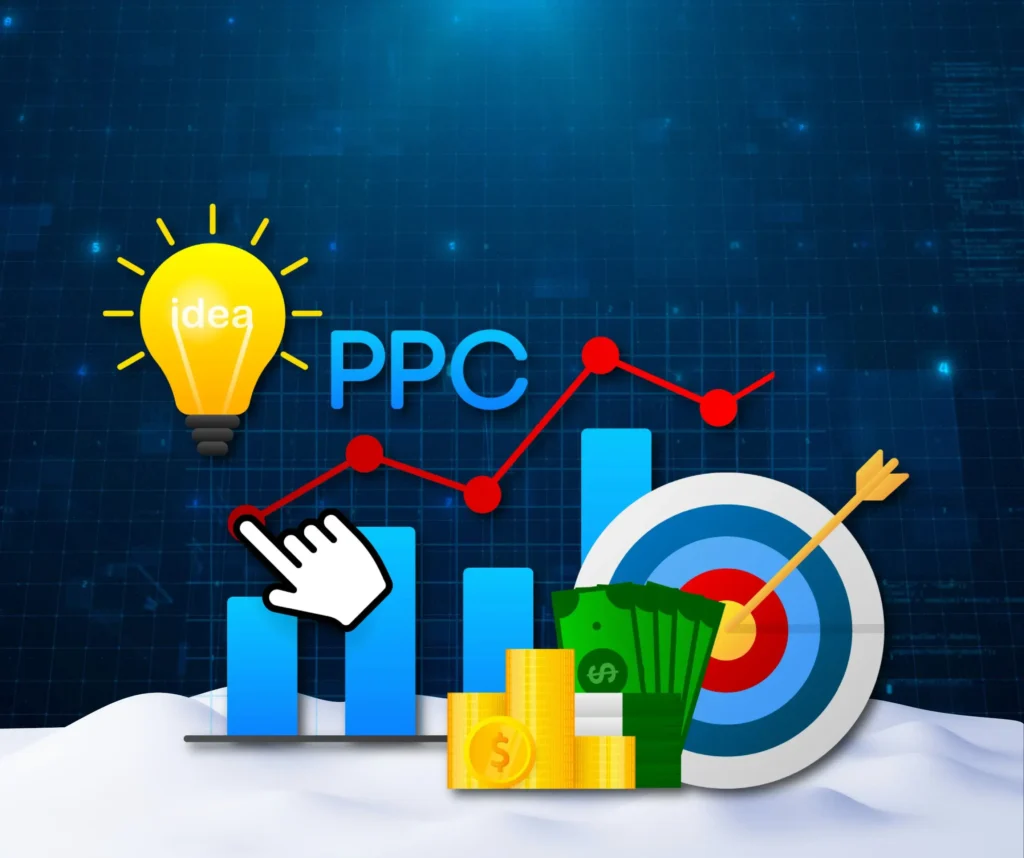
Understanding the Importance of Digital Marketing for Small Businesses
Nowadays Digital marketing is also important to any small business, enabling a level playing field in reaching a broad audience without the exorbitant costs of traditional marketing. It enhances visibility, builds brand reputation, and fosters direct engagement with potential customers.
Benefits of Implementing a Digital Marketing Strategy
A strategic approach yields multifaceted benefits: increased brand awareness, targeted audience reach, higher conversion rates, and cost-effective campaigns, bolstering sales and fostering long-term customer relationships.
Here is a 9-step Checklist for Small Business in Digital Marketing
1. Setting Clear Goals

Setting clear goals in digital marketing for any business is crucial for focused and measurable outcomes. Clear goals provide a roadmap, guiding strategies and actions toward desired achievements.
Determining Specific and Measurable Objectives:
When setting goals for your digital marketing, it’s vital to define specific and measurable objectives that tie directly into your business’s vision. For instance, if your aim is to boost brand awareness, consider metrics like social media engagement rates or website traffic from new visitors. These precise goals, such as increasing engagement by 30% in six months, provide clear benchmarks to assess progress.
Aligning Goals with Business Values and Target Audience:
Aligning your marketing goals with your brand values and the preferences of your target audience is crucial. For example, if your business prioritizes sustainability and your audience values eco-friendly products, a marketing goal could involve highlighting your sustainable practices to resonate with your environmentally conscious audience. This alignment fosters authenticity, increasing the effectiveness of your marketing strategies.
Developing Key Performance Indicators (KPIs):
Crafting KPIs that reflect your goals is fundamental for effective performance tracking . For instance, if your objective is to increase website traffic, KPIs like unique visitors per month or average session duration can gauge the success of your strategies. These KPIs act as compass points, guiding your marketing efforts and allowing for agile strategy adjustments.
2. Identifying Target Audience

Conducting Market Research and Creating Buyer Personas
Through extensive market research, you delve into consumer behavior, preferences, and trends, forming comprehensive buyer personas that illuminate their specific needs and desires. For instance, understanding the demographics and psychographics of your audience helps tailor marketing strategies to resonate effectively.
Analyzing Competitors and Identifying Unique Selling Propositions
By scrutinizing competitors, you unearth areas where your business can stand out. This analysis enables the identification of your unique selling proposition, carving a niche and offering distinct value to your audience. For instance, recognizing what sets your product apart from others in the market fosters a competitive edge.
Refining Target Audience and Segmenting Based on Demographics, Psychographics, and Behaviours
Segmenting your audience based on demographics, psychographics, and behavior creates refined groups for precise targeting. Tailoring content and engagement for each segment strengthens connections. For example, personalizing emails based on customer behavior increases engagement and conversions.
3. Crafting a Compelling Brand Identity

Defining and Communicating Core Brand Values
Ensure the clear definition and effective communication of your core brand values through all communication channels. This authenticity fosters trust and loyalty among your audience, establishing a deeper connection.
Creating a Memorable Brand Name and Logo
Crafting a memorable brand name and logo is pivotal for enhancing brand recall, especially in a fiercely competitive market.
Developing Brand Tone and Voice for Consistent Messaging
Developing a consistent tone and voice across various platforms plays a vital role in reinforcing brand identity. For example, Coca-Cola maintains a consistent brand voice of happiness and positivity across its marketing materials, consistently resonating with its global audience, creating a unified brand experience.
4. Building an Effective Website

Ensuring Mobile Responsiveness and User-Friendly Interface
Crafting a website with mobile responsiveness and a user-centric interface is vital in today’s mobile-driven market. This design ensures easy access for users regardless of the device they use.
Optimizing Website Speed and Performance
Enhancing website speed leads to an improved user experience and positively impacts search engine rankings, consequently enhancing overall visibility. Incorporating strategies like browser caching and image optimization reduces loading times, benefiting user satisfaction and SEO efforts simultaneously.
Implementing Clear Navigation and Compelling Content
Clear and intuitive website navigation combined with compelling, informative content encourages visitors to stay longer and increases the likelihood of conversions. Implementing prominent call-to-action buttons within informative content sections guides users seamlessly through the desired actions, facilitating conversions.
5. Implementing Search Engine Optimization (SEO)

Performing Keyword Research and On-Page Optimization
Conducting keyword research guarantees content relevance, which is pivotal for ranking higher in search results. Simultaneously, implementing on-page optimization techniques aids in improving visibility by aligning content with user search intent. For instance, a business selling eco-friendly products could use keywords like “sustainable living” or “environmentally friendly items” to enhance their content relevance.
Creating High-Quality and Engaging Content
Crafting compelling content synergizes with SEO tactics to captivate and retain visitors, contributing significantly to improved rankings and audience engagement. This could involve incorporating visual elements, interactive tools, or informative guides to enhance user experience and encourage longer site visits. An example would be a cooking blog that offers engaging recipes, cooking tips, and captivating visuals to entice readers and keep them coming back for more.
Building Quality Backlinks and Monitoring SEO Performance
Developing quality backlinks fortifies website credibility and authority, amplifying its visibility in search engines. Simultaneously, constant monitoring of SEO performance through analytics tools helps in understanding the effectiveness of implemented strategies and making necessary refinements for sustained growth.
6. Leveraging Social Media Marketing

Choosing Appropriate Social Media Platforms
To maximize impact, opt for social media platforms that resonate with your audience demographics and content style. For instance, if your business targets a younger audience interested in visual content, platforms like Instagram or TikTok might be more suitable.
Developing a Content Strategy and Posting Consistently
Crafting a robust content strategy and maintaining a consistent posting schedule are pivotal for fostering engagement and nurturing community growth. For instance, a diverse content mix, including informative articles, interactive polls, and engaging videos, can keep your audience engaged and interested in your brand.
Engaging with Followers and Analyzing Social Media Metrics
Engagement with your audience and analyzing social media metrics yield invaluable insights. This facilitates the refinement of content strategies, ensuring they align perfectly with your audience’s preferences.
7. Developing Pay-Per-Click (PPC) Advertising Campaigns

Setting Up Targeted PPC Campaigns
Precise targeting in PPC campaigns ensures cost-efficient ad spend. By reaching the intended audience effectively, you maximize the impact of your ads. For instance, if you’re promoting a fitness app, targeting fitness enthusiasts instead of a broad audience yields better results.
A/B Testing and Optimizing Ad Performance
Conducting A/B testing in PPC campaigns is crucial. This process refines campaigns by comparing variations, optimizing for the maximum impact and higher conversions. For example, testing different ad headlines or images helps identify what resonates better with the audience.
Conversions Tracking and ROI
Tracking conversions and ROI is pivotal for informed decision-making. Monitoring these metrics allows for guided budget allocation and strategic enhancements. For instance, understanding which keywords or ad copies generate higher ROI helps prioritize investments.
8. Implementing Email Marketing Campaigns

Building an Opt-In Email List and Segmentation:
Constructing an opt-in list and segmenting subscribers enables tailored content delivery, enhancing user engagement. For instance, a fitness company gathers subscribers interested in yoga separately from those keen on weightlifting, delivering customized content catering to their specific interests and needs.
Creating Personalized and Engaging Email Content:
Crafting compelling, personalized content heightens engagement levels and effectively nurtures leads. An example could be an e-commerce brand sending personalized product recommendations and exciting offers based on a customer’s previous purchases, enticing them to explore further and potentially make new purchases.
Measuring Email Campaign Success and Nurturing Leads:
Tracking metrics such as open rates and click-throughs serves as crucial indicators of campaign success, aiding in the nurturing of leads.
9. Analyzing and Adapting Strategies

Employing Analytics Tools for Performance Tracking and Metrics Assessment
Utilize robust analytics tools to monitor Key Performance Indicators (KPIs), enabling informed and data-centric decision-making. For instance, employing Google Analytics helps in tracking website traffic, user behavior, and conversion rates, offering valuable insights into the effectiveness of marketing campaigns.
Engaging in A/B Testing and Innovating with Fresh Approaches
Continuously experiment with A/B testing to refine strategies, ensuring optimal results and staying abreast of evolving market preferences. For example, testing different versions of ad copies or website layouts assists in identifying the most engaging content for the audience.
Employing Data-Driven Approaches for Enhanced Performance
Leverage data insights to drive decision-making, allowing for strategic pivots and optimization to foster sustained growth.
Starting a new brand involves numerous considerations, and the initial steps are crucial for establishing a robust online presence. The first five points play a pivotal role in laying a strong foundation for future digital expansion. As seasoned digital marketers, our recommendation is to begin by strategically setting goals and developing a fundamental website. This strategic approach allows for progression into email, social media, and PPC campaigns aligned with the brand’s objectives, facilitating further digital growth. However, the direction taken should be contingent upon the brand’s goals and its specific industry to ensure tailored and effective strategies.
Results vary based on strategy and industry; typically, initial results might be visible within a few months, but long-term success often takes 6-12 months or more.
Key components include platform selection aligned with the audience, consistent content strategy, engagement with followers, and metrics analysis for refinement.
Yes, digital marketing offers scalable and cost-effective solutions suitable for various small business types, enhancing visibility and engagement.
Key metrics encompass website traffic, conversion rates, click-through rates, bounce rates, and social media engagement metrics like likes, shares, and comments
In conclusion, this comprehensive checklist for Small Businesses in Digital Marketing, serves as your roadmap to navigate the complex terrain of digital marketing. Implementing these steps empowers small businesses to craft impactful strategies, foster meaningful connections, and drive sustainable growth in the digital landscape. Should you have any additional questions or seek further guidance, don’t hesitate to reach out. Your success in the realm of digital marketing is our priority, and we’re here to support your journey.
Author



